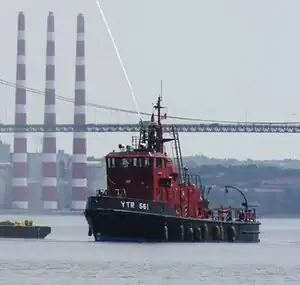 CFAV Firebird in Halifax harbour | |
| Class overview | |
|---|---|
| Name | Fire class |
| Builders | Vancouver Shipyards |
| Operators | |
| In service | 1978-present |
| Completed | 2 |
| Active | 1 |
| Laid up | 1 |
| General characteristics | |
| Type | Fireboats / Yard tractor tugs |
| Displacement | 140 tonnes (138 long tons) |
| Length | 23.1 m (75 ft 9 in) |
| Beam | 6.4 m (21 ft) |
| Draught | 2.6 m (8 ft 6 in) |
| Propulsion |
|
| Speed | 11 knots (20 km/h; 13 mph) |
| Complement | 5 |
| Equipment: | 3 × manually-controlled 3-inch (7.6 cm) water cannons 2 × diesel-driven fire pumps, 2,500 gpm at 150 psi each |
The Fire-class fireboats/yard tractor tugs were two fireboats operated by the Royal Canadian Navy. The two vessels are CFAV Firebrand (YTR 562) and CFAV Firebird (YTR 561).[1]
Design and construction
Firebird was based at CFB Halifax, and Firebrand at CFB Esquimalt.[1] According to the Canadian American Strategic Review the class was designed by naval architects Robert Allan Limited, and were built at Vancouver Shipyards in North Vancouver in 1978,[2] and later acquired by the Canadian Forces.
The two ships displaced 140 tonnes (138 long tons) and were 23.1 metres (75 ft 9 in) long, with a beam of 6.4 metres (21 ft) and a draught of 2.6 metres (8 ft 6 in). The ships were powered by two 365 horsepower (272 kW) azimuthing Z-drives and one hydraulic tunnel bow thruster. This gave the vessels a maximum speed of 11 knots (20 km/h; 13 mph). The ships had a crew of five firefighters.[3]
The Fire class was equipped with three manually-controlled 3-inch (76 mm) water cannons, two diesel-driven fire pumps capable of expending 2,500 gpm at 150 psi each.
Ships in class
| Number | Name | Builder | Laid down | In service | Status |
| YTR 561 | Firebird | Vancouver Shipyards, North Vancouver | 1978 | 1978-2014 | Awaiting disposal |
| YTR 562 | Firebrand | 1978 | In active service | ||
Service history
In 2008, Firebird helped extinguish a fire aboard the former Canadian Coast Guard vessel CCGS Tupper in Halifax harbour.[3]
On 4 December 2012 the Department of National Defence published a Letter of Interest (LOI)/Request for Information (RFI) for Canadian shipbuilders interested in building replacements for the Glen-class tugs¸ and Fire-class fireboats.[4][5]
A single class would replace both the tugs and the fireboats, and would be operated by civilian crews. The replacement vessels would have water cannons that could be controlled remotely, by a single individual. The replacement vessels would have bollard pull of 40 tons—almost six times as much as the 7.5 tons the Fire-class vessels are capable of.
On 29 January 2014, the availability of Firebird to fight fires was reduced due to budget cuts, being on standby only during weekdays during normal working hours.[6] On 4 December 2014, Firebird was taken out of service in Halifax, and placed on the disposal list as a result of budget cuts. The ship will be replaced using tugboats from around the harbour.[3][7]
Replacement
On 29 April 2019 the Government of Canada announced Ocean Industries of Isle-aux-Coudres, Quebec was awarded the contract to build four tow-tug/rescue vessels to replace both the Fire-class fireboat/tractor tugs and Glen-class yard tugs with delivery expected from 2021 to 2023.[8] The new tugs will be staffed by civilian crews and be restricted to the naval base/yard only.
References
- 1 2 "Canadian Forces Small Ships — the Fire class YTR Rescue Boats". Canadian American Strategic Review. Archived from the original on 2 March 2008. Retrieved 13 February 2008.
- ↑ "The Canadian Navy Fire Fighting Tug Firebird at Halifax".
- 1 2 3 vanKampen, Stephanie (10 December 2014). "Royal Canadian Navy cuts fire service in Halifax Harbour". CBC News. Retrieved 14 November 2015.
- ↑ "Future CF Harbour Tugs – The Naval Large Tug Construction Project". Canadian American Strategic Review. August 2013. Archived from the original on 28 September 2013.
Note that the Naval Large Tug Construction Project is not part of the National Shipbuilding Procurement Strategy. Under Section 10 of the NSPS Umbrella Agreement, ships displacing less than 1,000 tonnes must go to competition outside NSPS-contracted shipyards. That was meant to spread the Federal spending among the smaller yards. That sounds good but DND wants all six Naval Large Tugs to be built by a single yard. So much for spreading it around.
- ↑ Gordon, Rob (29 January 2014). "Navy slashes fire service in Halifax Harbour". CBC. Retrieved 14 November 2015.
- ↑ "Navy fireboat shut down". Chronicle-Herald. 10 December 2014. Retrieved 14 November 2015.
- ↑ Pugliese, David (29 April 2019). "Ocean Industries to build four tugs for the Royal Canadian Navy". Ottawa Citizen. Retrieved 10 May 2019.